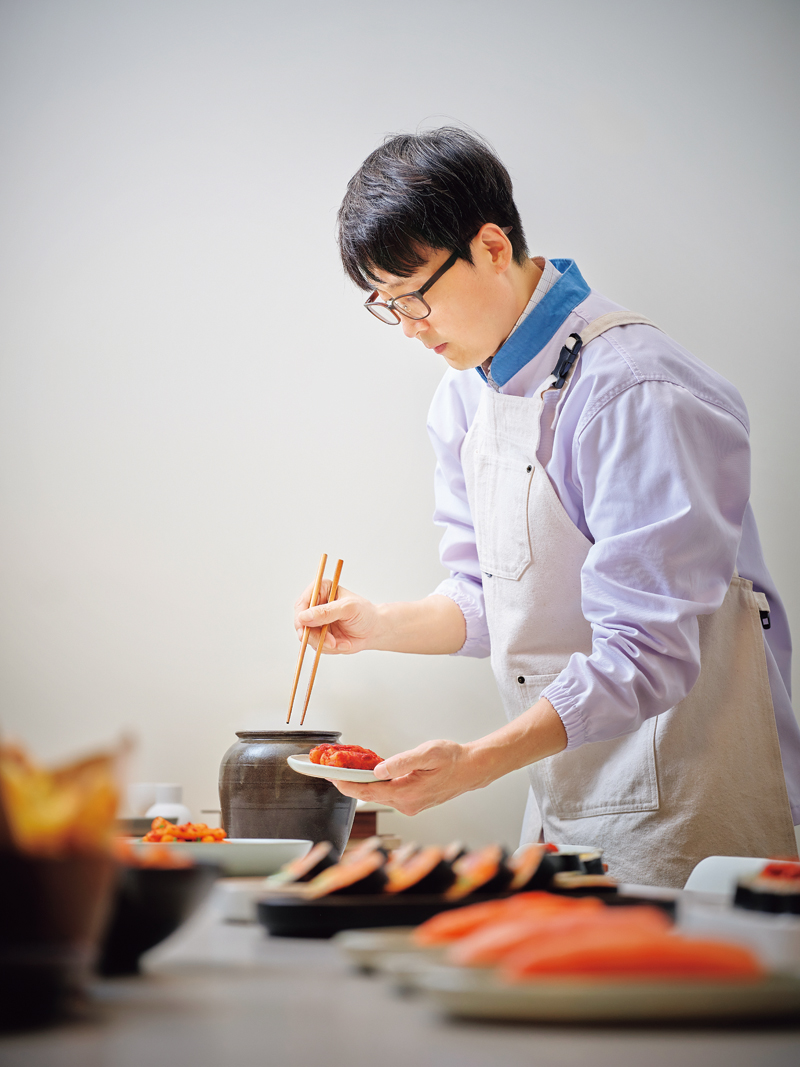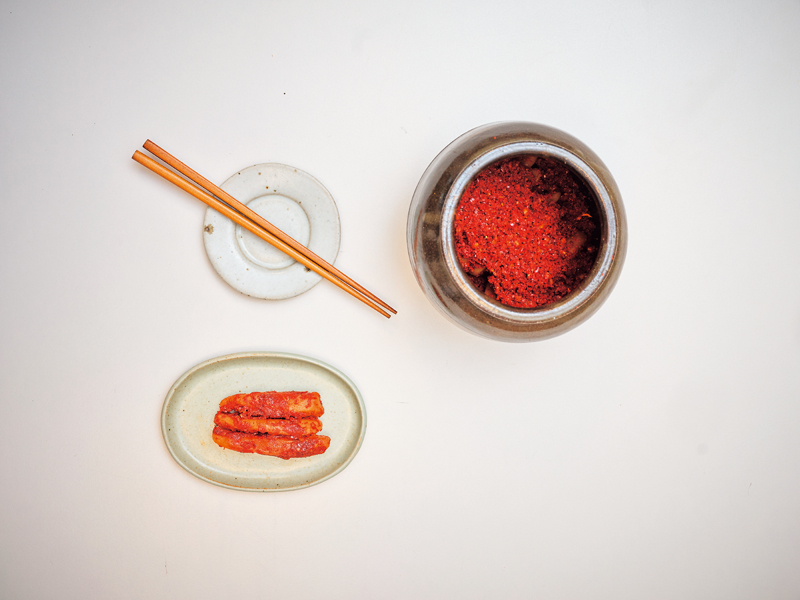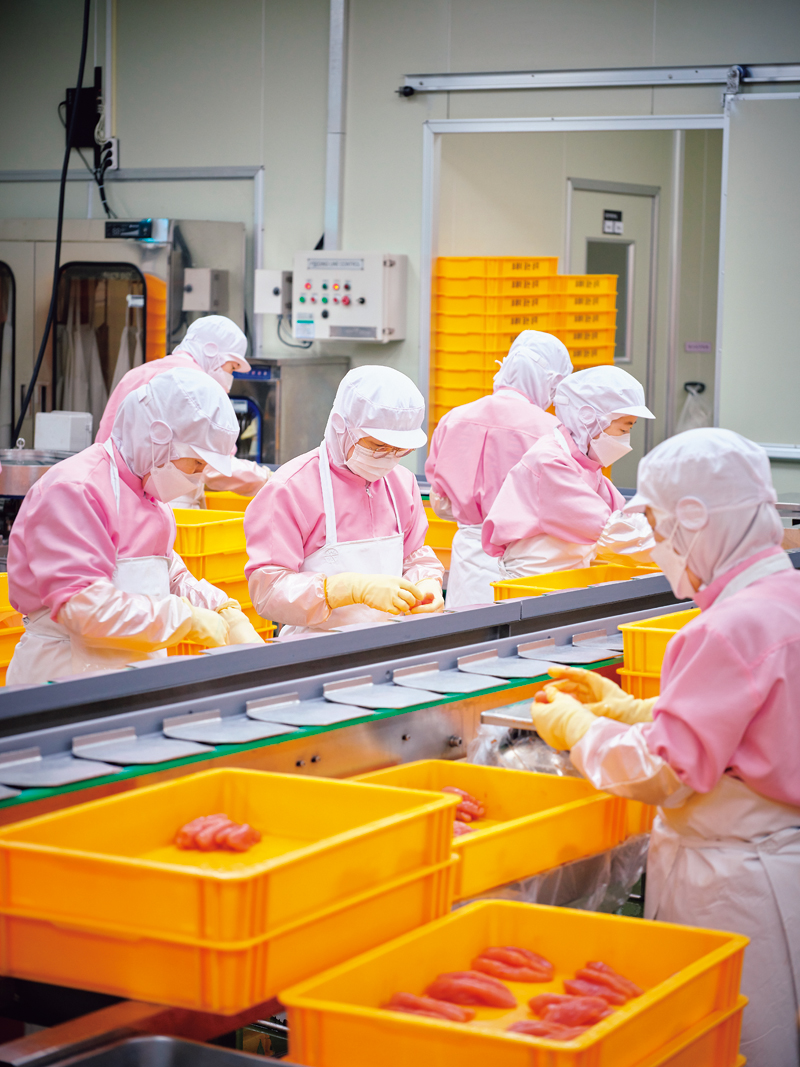Deokhwa Food, based in Busan, has gained recognition for reviving the traditional recipe of
myeongnan jeot (salted pollock roe), thereby reestablishing Korea’s status as the birthplace of this delicacy. The company, along with the recipe, has been handed down from father to son.

Deokhwa Food CEO Jang Jong-su arranges dishes featuring myeongnan jeot (salted pollock roe). Through his corporate research institute, Jang has illuminated the history and value of this traditional delicacy, while also developing modern recipes. Together with his father, he successfully revived the long-forgotten traditional production method.
Pollock has always been one of Koreans’ favorite fish. Its roe sac, called myeongnan, is salted and fermented to make myeongnan jeot, a traditional side dish that has long been placed on Korean dining tables. As the saying goes, well-fermented and salted seafood (jeot or jeotgal) is a bapdoduk (rice thief), since its intense flavor makes the diner crave more rice. A bit of myeongnan jeot seasoned with sesame oil on a spoonful of freshly cooked rice makes other side dishes seem unnecessary. Beyond its standalone appeal, it’s a natural salty seasoning that enhances the flavor of both Asian and Western cuisine, such as in sandwiches, pasta, and various appetizers.
Myeongnan jeot originated in Korea some four hundred years ago, before being introduced to Japan during the colonial period. There it was modified to local tastes, and today Japan consumes nearly 80 percent of the world’s pollock roe, leading many to mistake it for a Japanese food. However, historical records confirm that it was a common side dish that originated during the Joseon Dynasty (1392–1910) and was enjoyed across Korea, both in the royal court and in common households.
Seungjeongwon ilgi (Diaries of the Royal Secretariat), listed on the UNESCO Memory of the World Register, contains the world’s first documented reference to pollock roe, noting that the Joseon court received it as a tribute from Gangwon Province in 1652. The earliest detailed description of its preparation appears in Nanho eomokji, an encyclopedia of marine products written around 1820 by late Joseon scholar Seo Yu-gu (1764–1845). After the Korean War (1950–1953), the major fishing grounds for pollock in Hamgyeong Province and part of Gangwon Province were incorporated into North Korea, while overfishing and rising sea temperatures depleted pollock stocks in the South. Myeongnan jeot gradually disappeared from Korean tables and was replaced by mentaiko, Japanese-style pollock roe.
REVIVED RECIPE
Thanks to Busan-based Deokhwa Food, the lost art of producing Joseon-style myeongnan jeot has been revived. Founded in 1993, the company has focused exclusively on pollock roe products since 2000. Founder Jang Sug-zuen (1945–2018) was among the first to learn the Japanese preparation method when it was reintroduced to Korea in the 1970s. In 2011, his efforts to incorporate traditional methods into the imported recipe were acknowledged by the Ministry of Employment and Labor, which awarded him the title of Korean Master Hand, the first time this honor was bestowed on a craftsperson in the seafood manufacturing sector.
Jang proved his expertise in Japan, renowned for its strict food standards, and was quick to establish export channels. Between late 2008 and 2015, his company was the exclusive supplier for all private-label pollock roe of Seven & I Holdings, one of Japan’s largest retail holding companies, known for its 7-Eleven convenience stores. It was the first time Seven & I had outsourced its private-brand mentaiko production to a company outside Japan.
The Busan International Fish Market at Gimcheon Port, home to Deokhwa Food, is a major seafood hub where the majority of global pollock roe trade takes place. While South Korean fishers no longer catch pollock locally, Busan functions as a main trading hub thanks to Russian vessels using it as an export gateway. All frozen pollock roe in the global market — 70 percent from Russia and 30 from the United States — is imported by Japan and Korea.
“The first secret to making the best myeongnan jeot is securing high-quality roe with a firm texture and bright red color. Since 2018, we’ve been purchasing all premium-grade pollock roe sacs distributed worldwide,” says Jang Jong-su, the current CEO, who inherited the company from his late father. “It surprises the shipping companies,” he added, radiating immense pride in his company’s dealings.

Traditional Joseon-style myeongnan jeot, which undergoes a longer fermentation period, has a higher salt content and chewier texture than its modern counterpart. The roe is aged in premium earthenware jars where it develops a deep flavor; when it’s properly fermented, it has a subtle, savory aroma.
SKILLED ARTISANS
Myeongnan jeot is produced in three main stages: thawing, salting, and aging. Frozen roe sacs are first thawed in a temperature-controlled room. Then they are salted in brine at a specific concentration, which requires experience and scientific analysis to adjust the amount of salt and water and vary the temperature depending on the roe’s condition. The brined roe sacs develop their flavor during the aging stage, when rice wine and extra salt are added to produce white myeongnan. Condiments such as red pepper powder, ground garlic, ginger, and again salt are used to produce a seasoned version. The final products are graded based on the size, texture, color, and shape of each roe sac.
“Good myeongnan jeot has the aroma of well-fermented seafood. The key is the subtle, pleasantly briny smell and the flavor released when the eggs burst in your mouth. The texture is achieved in the salting stage,” Jang explains.
Due to the delicate nature of pollock roe, it is prepared with stringent sanitation processes in place, for which Deokhwa Food is recognized in the industry. However, Jang says the most important thing is working with skilled food artisans.
“While our production lines have been largely automated, expert judgment is still essential, particularly when adjusting the brine salinity based on daily variations in roe conditions or grading the final products. Our artisans, who have over twenty years of experience, are our greatest asset.”

After first being salted and aged, the pollock roe undergoes a careful grading and selection process. Though this final stage may appear straightforward, it demands extensive experience and expert judgment.
LEGACY OF MASTERS
Before joining Deokhwa Food in 2006 at his father’s request, Jang studied economics in college and worked in Seoul.
“At the time, I was managing public funds at the Korea Environment Corporation and considering going abroad to pursue a graduate degree. But my father, who had never let on that he was struggling, was having a hard time after building our own factory. When he asked me to join him, I immediately agreed,” says Jang.
His father’s first directive was to develop a domestic market for myeongnan jeot, as the company relied entirely on exports to Japan at the time. So, Jang spent his first six months on the job in Japan, studying the country’s advanced production system.
“Japanese mentaiko uses less salt and is cured with katsuo dashi [stock made from dried and smoked bonito] and cooking wine. It’s less salty but sweeter. The low-sodium curing method we use today was reintroduced from Japan and adapted to Korean tastes. However, my father remembered the traditional taste and was determined to revive and commercialize the age-old curing method.”
In 2009, father and son established a corporate research institute, the first in the processed roe industry. Continued research into traditional methods led them to natural fermented lactic acid bacteria, enabling the company to produce flavors suited to Korean tastes without using artificial coloring or preservatives. When many exporters faced bankruptcy due to the sharp depreciation of the yen in 2012, Deokhwa Food managed to survive the crisis thanks to its preemptive preparations for the domestic market. After extensive study of historical documents, the company eventually succeeded in reviving traditional Joseon-style myeongnan jeot.
“The process of gently fermenting pollock roe using only salt, red pepper powder, and garlic is exclusively found on the Korean peninsula. The taste can only be obtained using red peppers and garlic grown in the traditional way,” Jang explains. In recognition of his contribution to reviving and developing the traditional myeongnan jeot recipe, he was designated as Korean Seafood Grand Master by the Ministry of Ocean and Fisheries in 2022. The Jangs are the only father and son duo in Korea to have earned official master titles.
“While the salt content of Japanese mentaiko is four percent, that of Joseon myeongnan jeot is about seven percent. It’s saltier and has a chewier texture. Although it’s a bit salty, food fermented the traditional way is healthy and has a greater depth of flavor,” Jang says.
When asked about his ultimate goal, he replies without hesitation: “To make the world’s finest myeongnan jeot.”